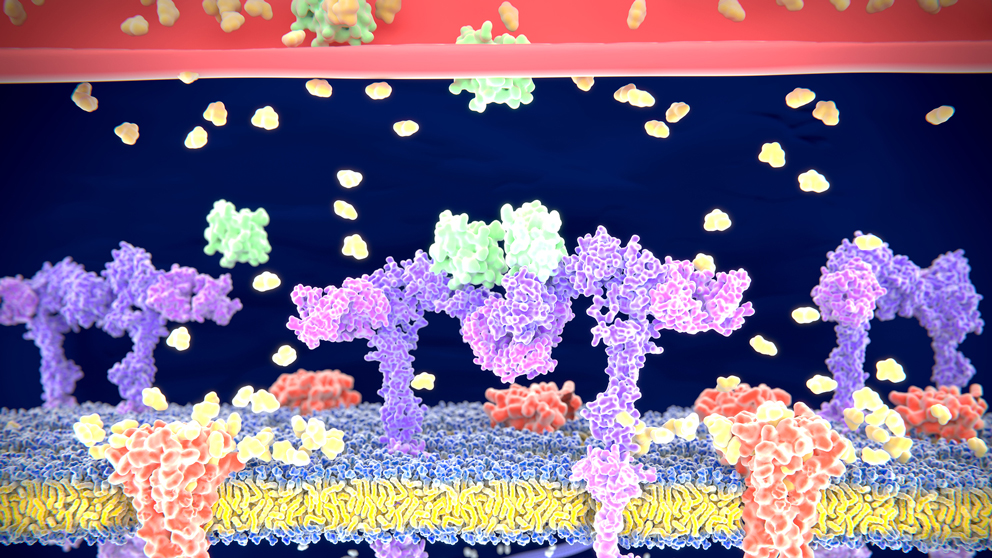
The insulin receptor (violet) is a transmembrane protein that is activated by insulin (light green).
Harnessing a specific immune response to prevent inflammation could prevent insulin resistance, cardiovascular disease
We’ve all read enough headlines to know the equation: A high-fat diet leads to obesity, which leads to the so-called metabolic syndrome, an unhealthy confluence of conditions that may include insulin resistance and high blood sugar, high levels of cholesterol and triglycerides in the blood, hypertension and cardiovascular disease. But what if this progression could be interrupted?
An important driver of metabolic syndrome is inflammation in the body’s visceral white fat. As it turns out, says Jackson Laboratory (JAX) Research Scientist Daniel Skelly, Ph.D.Biologist and data scientist harnessing single cell functional genomics and genetically diverse mice to study complex traitsDaniel Skelly, Ph.D. , and Associate Research Scientist John Graham, Ph.D. I am interested in how genetic background influences the function of the immune system in tumors and visceral fat. John Graham, Ph.D., certain white blood cells interact directly with white fat to depress inflammation. But these important regulatory cells, known as invariant natural killer T (iNKT) cells, tend to decrease in white fat as a person transitions from lean to obese.
To account for this loss, Graham and Skelly are studying the genetic differences that endow each individual, human or mouse, with a different quantity of iNKT cells. “Most of our knowledge of the regulation of white fat comes from studies of a single inbred mouse strain,” Skelly notes. “To better understand the functioning of the immune system of white fat, we’re looking at immune cells in a Genetically diverse mice show human-like responses to heart attackA research team led by Nadia Rosenthal, Ph.D., documented large differences in survival, cardiac dilation and scar size among a population of genetically-diverse mice.genetically varied mouse population , the Collaborative Cross, that approximates levels of genetic diversity found in humans.”
Skelly and Graham have received a two-year exploratory research grant totaling $467,500 from the National Institute of Allergy and Infectious Diseases to pursue their hypothesis that genetic differences in iNKT cell abundance in fat affect the consequences of high fat diet-driven inflammation.
The genetically diverse mice, fed either a How do you make a Western diet — for a mouse?Researchers at JAX are exploring the role of diet in a myriad of diseases related to aging, including glaucoma and Alzheimer's disease.high-fat diet or a typical, grain-based diet, will be monitored for signs of metabolic syndrome. “Our focus will be on the role of iNKT cells as members of a complex immune cell network,” Graham says, “where cells communicate with each other and can influence the behavior of other cells. By correlating immune cell abundance and indicators of metabolic disease, we will gain insight into the immune regulation of visceral fat.”
Skelly and Graham expect the project to produce valuable new mouse models for studying immune mechanisms involved in obesity-related diseases, with the ultimate goal of identifying potential therapeutic targets for the many diseases associated with metabolic syndrome.
“Using the Collaborative Cross to understand the impact of a high-fat diet on the adipose tissue invariant natural killer T-cell compartment,” National Institute of Allergy and Infectious Diseases, Grant Number: 1R21AI145383-01
Modeling human diversity... in mice!
How can scientific research get answers when there's so much human diversity? Mice, of course!